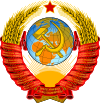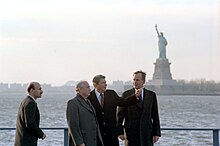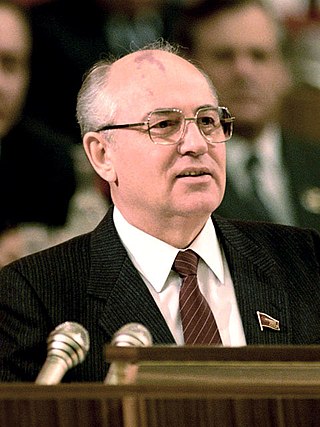
Mikhail Sergeyevich Gorbachev was a Soviet and Russian politician who served as the last leader of the Soviet Union from 1985 to the country's dissolution in 1991. He served as General Secretary of the Communist Party of the Soviet Union from 1985 and additionally as head of state beginning in 1988, as Chairman of the Presidium of the Supreme Soviet from 1988 to 1989, Chairman of the Supreme Soviet from 1989 to 1990 and the only President of the Soviet Union from 1990 to 1991. Ideologically, Gorbachev initially adhered to Marxism–Leninism but moved towards social democracy by the early 1990s.

Perestroika was a political reform movement within the Communist Party of the Soviet Union (CPSU) during the late 1980s widely associated with CPSU general secretary Mikhail Gorbachev and his glasnost policy reform. The literal meaning of perestroika is "restructuring", referring to the restructuring of the political and economic systems of the Soviet Union, in an attempt to end the Era of Stagnation.

Erich Ernst Paul Honecker was a German communist politician who led the German Democratic Republic from 1971 until shortly before the fall of the Berlin Wall in November 1989. He held the posts of General Secretary of the Socialist Unity Party of Germany (SED) and Chairman of the National Defence Council; in 1976, he replaced Willi Stoph as Chairman of the State Council, the official head of state. As the leader of East Germany, Honecker was viewed as a dictator. During his leadership, the country had close ties to the Soviet Union, which maintained a large army in the country.
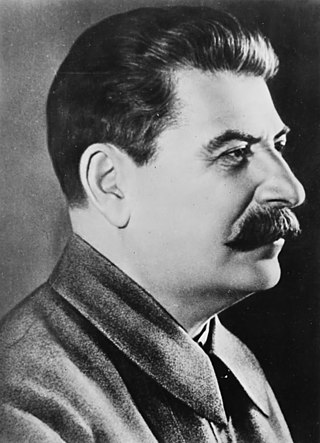
The General Secretary of the Central Committee of the Communist Party of the Soviet Union was the leader of the Communist Party of the Soviet Union (CPSU). From 1924 until the country's dissolution in 1991, the officeholder was the recognized leader of the Soviet Union. Prior to Stalin's accession, the position was not viewed as an important role in Lenin's government and previous occupants had been responsible for technical rather than political decisions.

The time period of around 1985–1991 marked the final period of the Cold War. It was characterized by systemic reform within the Soviet Union, the easing of geopolitical tensions between the Soviet-led bloc and the United States-led bloc, the collapse of the Soviet Union's influence in Eastern Europe, and the dissolution of the Soviet Union in 1991.

The Revolutions of 1989, also known as the Fall of Communism, was a revolutionary wave of liberal democracy movements that resulted in the collapse of most Marxist–Leninist governments in the Eastern Bloc and other parts of the world. Sometimes this revolutionary wave is also called the Fall of Nations or the Autumn of Nations, a play on the term Spring of Nations that is sometimes used to describe the Revolutions of 1848 in Europe. It may have contributed to the eventual dissolution of the Soviet Union—the world's largest Marxist–Leninist state—and the abandonment of communist regimes in many parts of the world, some of which were violently overthrown. The events, especially the fall of the Soviet Union, drastically altered the world's balance of power, marking the end of the Cold War and the beginning of the post-Cold War era.

The Malta Summit was a meeting between United States President George H. W. Bush and Soviet General Secretary Mikhail Gorbachev on December 2–3, 1989, just a few weeks after the fall of the Berlin Wall. It followed a meeting that included Ronald Reagan in New York in December 1988. During the summit, Bush and Gorbachev declared an end to the Cold War, although whether it was truly such is a matter of debate. News reports of the time referred to the Malta Summit as one of the most important since World War II, when British prime minister Winston Churchill, Soviet General Secretary Joseph Stalin and US President Franklin D. Roosevelt agreed on a post-war plan for Europe at the Yalta Conference.
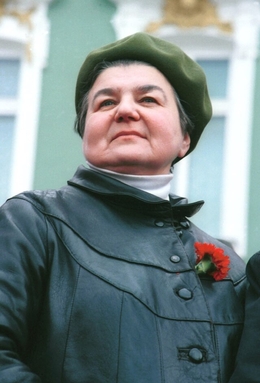
Nina Alexandrovna Andreyeva was a Soviet and Russian chemist, teacher, author, political activist, and social critic. A supporter of classical Soviet principles, she wrote an essay entitled I Cannot Forsake My Principles that defended many aspects of the traditional Soviet system, and criticized General Secretary Mikhail Gorbachev and his closest supporters for not being true communists. In the rebuke published in the official party newspaper Pravda the essay was called The Manifesto of Anti-Perestroika Forces.
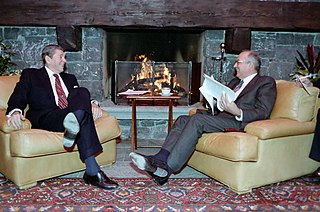
The Geneva Summit of 1985 was a Cold War-era meeting in Geneva, Switzerland. It was held on November 19 and 20, 1985, between U.S. President Ronald Reagan and Soviet General Secretary Mikhail Gorbachev. The two leaders met for the first time to hold talks on international diplomatic relations and the arms race.

The socialist fraternal kiss was a special form of greeting between socialist state leaders. The act demonstrated the special connection that exists between Communist countries, consisting of an embrace, along with a series of three kisses on alternate cheeks. In rare cases, when the two leaders considered themselves exceptionally close, the kisses were given on the mouth rather than on the cheeks.
Aleksandr Vlasov was a Soviet politician, who held different cabinet posts, including interior minister and prime minister. He was the last communist prime minister of Russia, and a close ally of Mikhail Gorbachev.
Vsevolod Serafimovich Murakhovsky was a Ukrainian-Soviet politician who served as first deputy premier during the leadership of Soviet general secretary Mikhail Gorbachev.
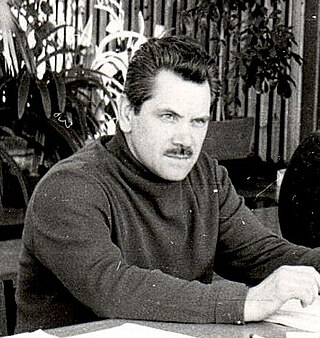
Anatoly Sergeevich Chernyaev was a Russian politician and writer, member of the Central Committee of the Communist Party of the USSR, who became foreign-policy advisor to General Secretary Mikhail Gorbachev in 1986-1991.

The Union of Soviet Socialist Republics (USSR) was dissolved on 26 December 1991 by Declaration № 142-Н of the Soviet of the Republics of the Supreme Soviet of the Soviet Union, formally establishing the dissolution of the Soviet Union as a sovereign state and subject of international law. It also brought an end to the Soviet Union's federal government and General Secretary Mikhail Gorbachev's effort to reform the Soviet political and economic system in an attempt to stop a period of political stalemate and economic backslide. The Soviet Union had experienced internal stagnation and ethnic separatism. Although highly centralized until its final years, the country was made up of 15 top-level republics that served as the homelands for different ethnicities. By late 1991, amid a catastrophic political crisis, with several republics already departing the Union and the waning of centralized power, the leaders of three of its founding members, the Russian, Belorussian, and Ukrainian SSRs, declared that the Soviet Union no longer existed. Eight more republics joined their declaration shortly thereafter. Gorbachev resigned on 25 December 1991 and what was left of the Soviet parliament voted to end itself.
The four-day Sino-Soviet Summit was held in Beijing from 15-18 May 1989. This would be the first formal meeting between a Soviet Communist leader and a Chinese Communist leader since the Sino-Soviet split in the 1950s. The last Soviet leader to visit China was Nikita Khrushchev in September 1959. Both Deng Xiaoping, the paramount leader of China, and Mikhail Gorbachev, General Secretary of the Communist Party of the Soviet Union, proclaimed that the summit was the beginning of normalized state-to-state relations. The meeting between Mikhail Gorbachev and then General Secretary of the Chinese Communist Party (CCP), Zhao Ziyang, was hailed as the "natural restoration" of party-to-party relations.
George H. W. Bush, whose term as president lasted from 1989 until 1993, had extensive experience with US foreign policy. Unlike his predecessor, Ronald Reagan, he downplayed vision and emphasized caution and careful management. He had quietly disagreed with many of Reagan's foreign policy decisions and tried to build his own policies. His main foreign policy advisors were Secretaries of State James Baker, a longtime friend, and National Security Advisor Brent Scowcroft. Key geopolitical events that occurred during Bush's presidency were:

The Helsinki Summit was a private, bilateral meeting between American President George H. W. Bush and Soviet President Mikhail Gorbachev that took place in Helsinki, Finland on September 9, 1990. Due to the vested interests of both the Soviet Union and the United States in the Gulf Crisis' resolution, August 1990 Iraqi invasion of Kuwait was the primary topic of discussion for the leaders during the Helsinki Summit. The concerted efforts at easing American-Soviet tensions in the aftermath of the Cold War was another prominent topic, among other notable current events. At the summit's conclusion, Presidents Bush and Gorbachev produced a document of joint statements that illuminated the areas in which the leaders had committed to aligning their foreign policy goals. The summit was followed by a press conference wherein members of the media questioned Presidents Bush and Gorbachev about the content of their meeting and the justifications for their joint statements.

The Governors Island Summit was a summit meeting between U.S. President Ronald Reagan and General Secretary of the Communist Party of the Soviet Union Mikhail Gorbachev. It was held on December 7, 1988. U.S. Vice President and President-elect George H. W. Bush was also in attendance.




